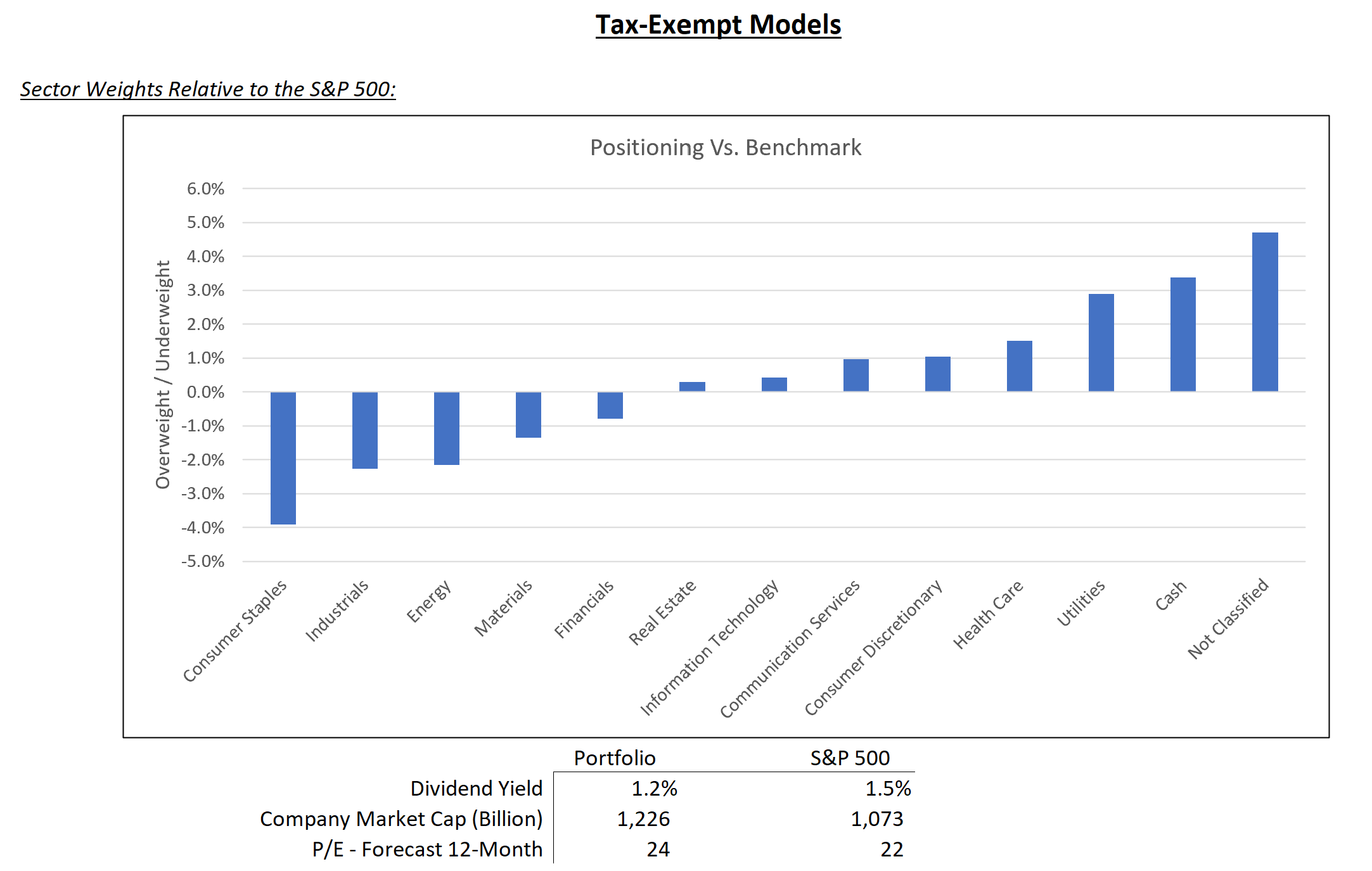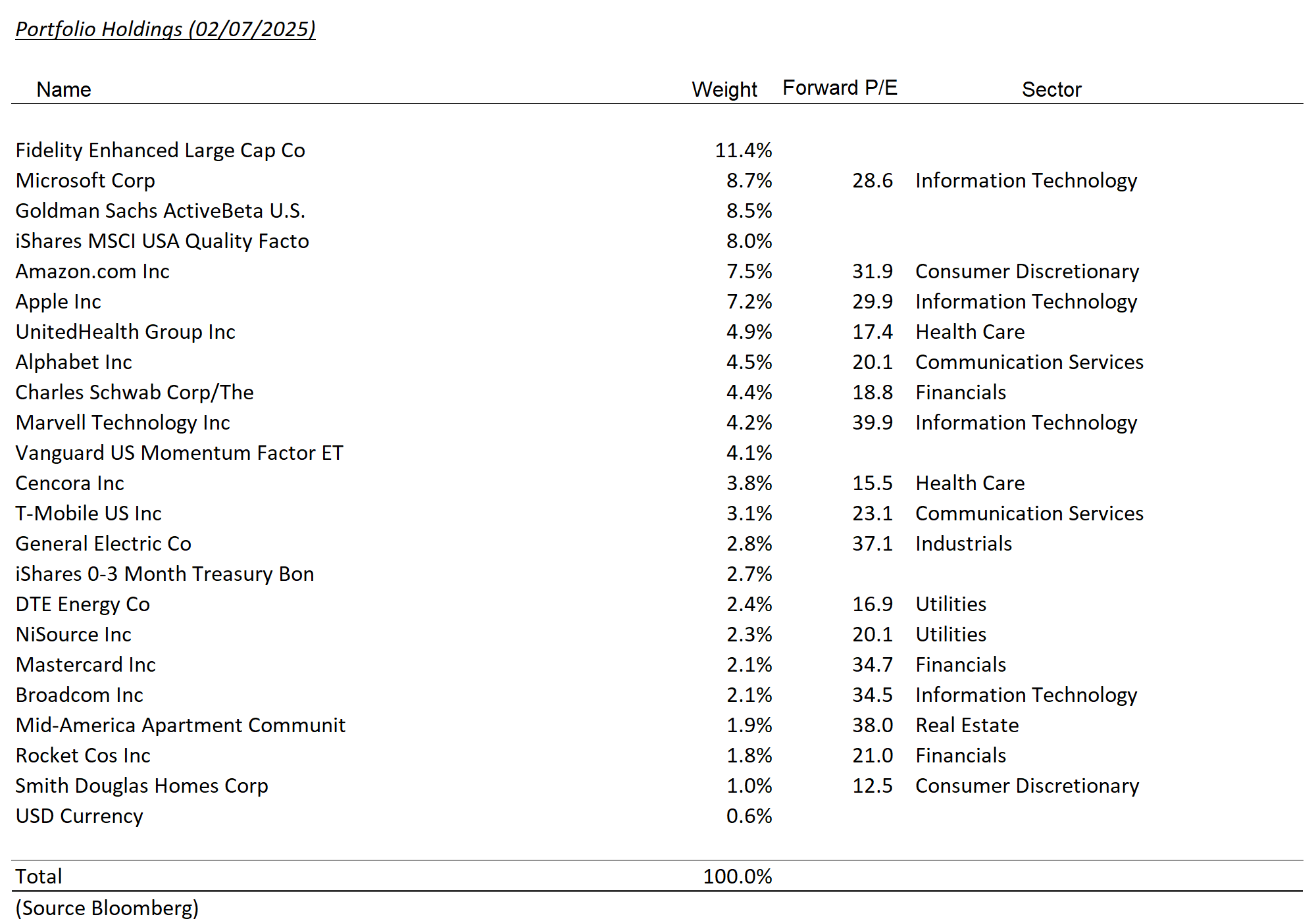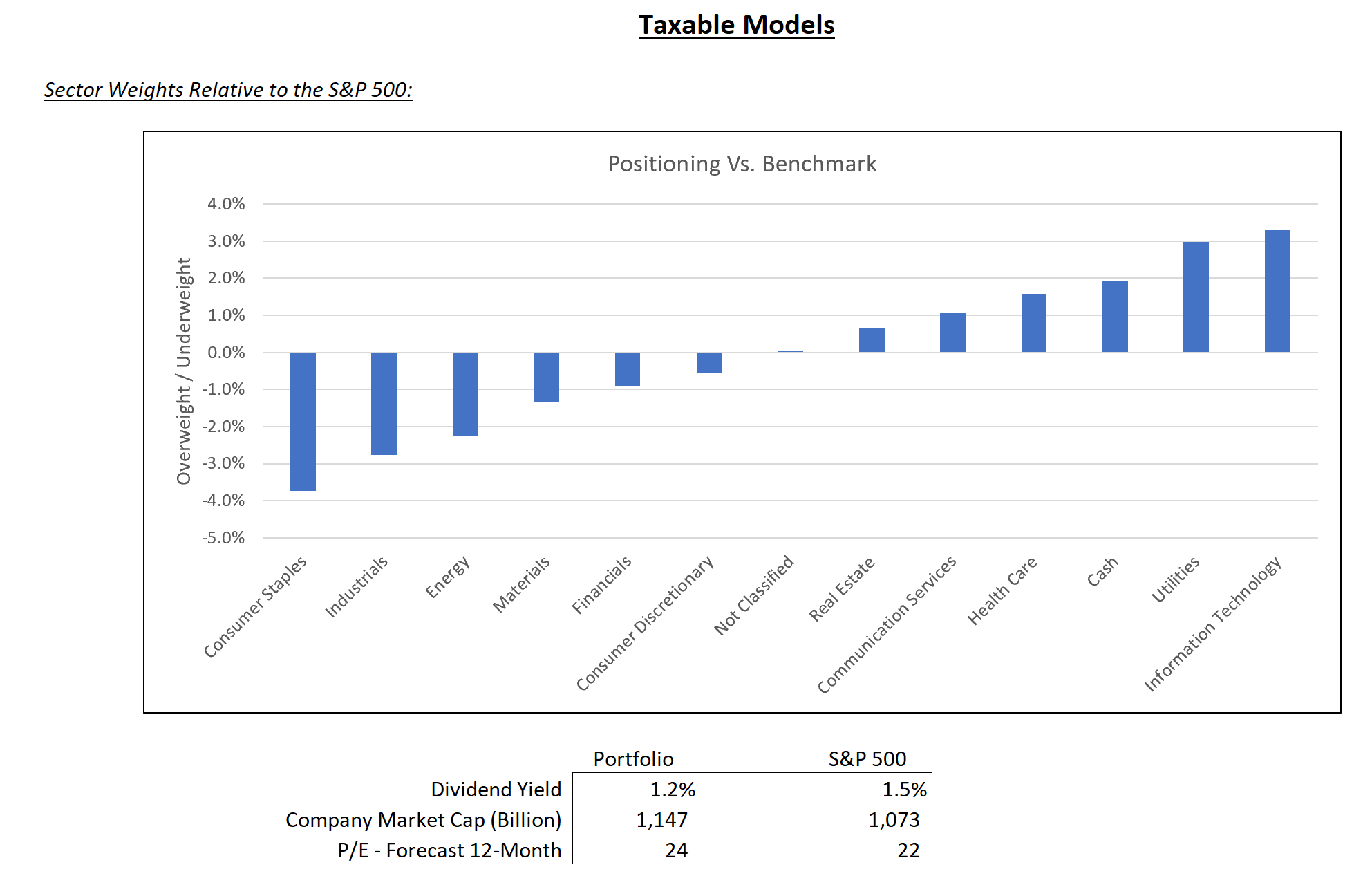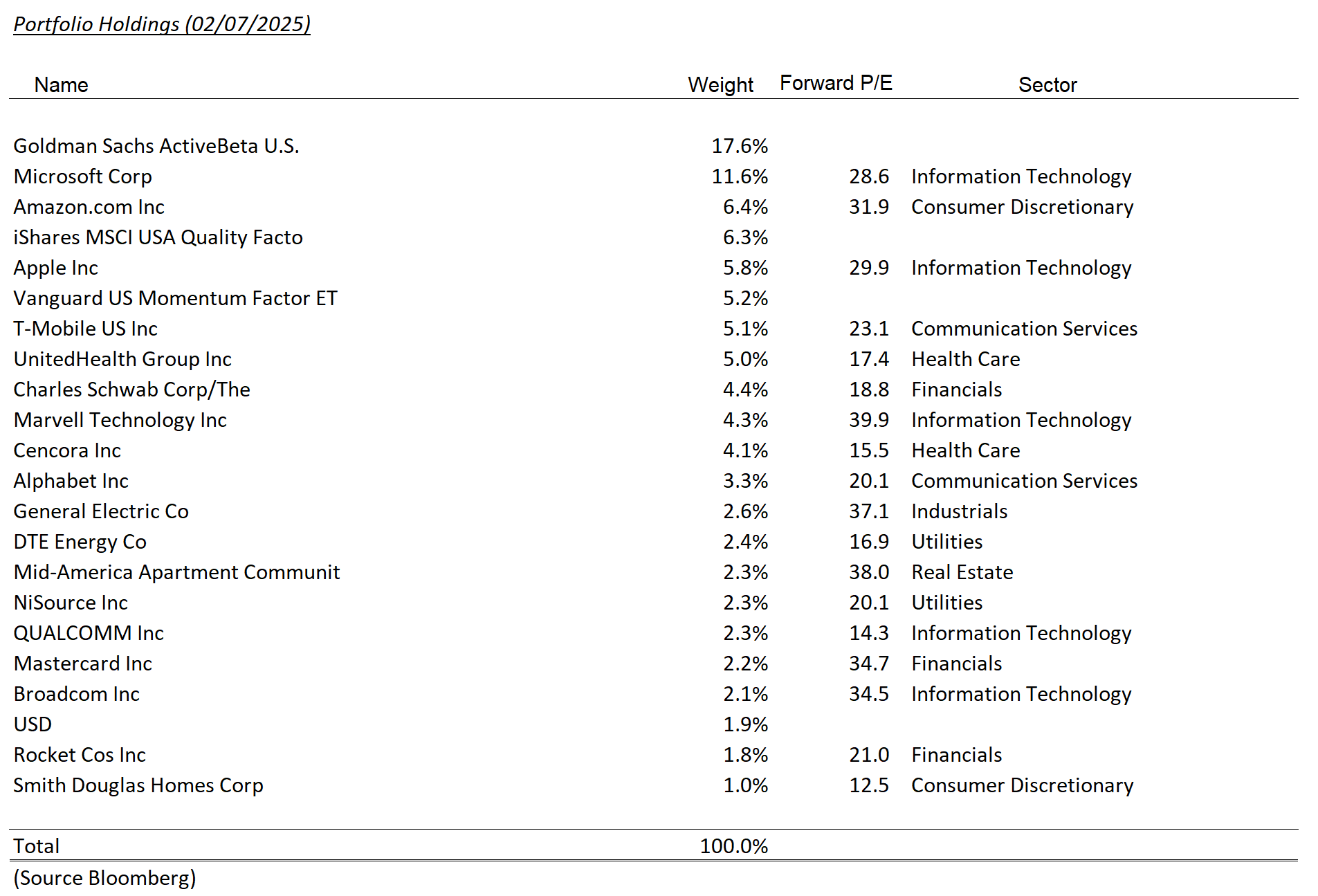January Changes
Tax Deferred
(for mobile swipe left to right)
| New Additions | Complete Sales | Partial Sales | Additional Buys | % of Account Traded |
|---|---|---|---|---|
| AVGO | 2.1% | |||
| MRVL | 4.2% | |||
| NI | 2.3% | |||
| NVDA | 3.6% | |||
| QCOM | 1.4% | |||
| TSN | 2.3% | |||
| TMUS | 1.9% | |||
| AMZN | 1.4% |
Taxable
(for mobile swipe left to right)
| New Additions | Complete Sales | Partial Sales | Additional Buys | % of Account Traded |
|---|---|---|---|---|
| AVGO | 2.1% | |||
| GE | 2.6% | |||
| MRVL | 4.3% | |||
| NI | 2.3% | |||
| AMD | 1.2% | |||
| NVDA | 1.9% | |||
| TSN | 2.3% | |||
| TXT | 2.3% | |||
| AMZN | 0.7% |
All portfolios and commentary reflect changes through February 7th.
Summary of Month’s Action
Though only a month in, 2025 has already delivered several surprises. Among the most notable were the market’s reaction to a rising Chinese AI competitor, which challenged expectations around capital expenditure trends, and former President Donald Trump’s sudden announcement of new tariffs—only to suspend them within 48 hours. Despite the intra-month volatility, the S&P 500 finished January with a 2.8% gain, with every sector posting positive returns except for Information Technology.
The initial shock of Trump’s tariff announcement rattled markets, but equities stabilized once the implementation of tariffs on Canada and Mexico was postponed. Our current, albeit tentative, view is that while Trump may introduce some tariffs, he remains highly attuned to stock market performance and overall economic health. If tariffs were to cause significant market strain, we suspect they could be reversed just as quickly as they were announced. Conversely, if markets remain resilient, Trump may feel emboldened to take a more aggressive stance. Given his unpredictable nature, we continue to assess the situation with caution.
January was an active month for Lincoln Capital portfolios, we will detail our most meaningful trades in the sections below.
Security Specific Comments:
NVIDIA Corporation (NVDA)
Broadcom Inc. (AVGO)
Marvell Technology, Inc. (MRVL)
Amazon.com, Inc. (AMZN)
Portfolio Updates: AI Disruption and Our Response
The following trades were driven by the market’s reaction to DeepSeek’s (DS) recent developments. For those unfamiliar with the story, DeepSeek is a Chinese AI research lab that has gained attention for its recent model releases. As Silicon Valley and Wall Street grasped the implications of these advancements, uncertainty spread rapidly, sending AI-related stocks sharply lower.
Leading AI labs are racing to achieve Artificial General Intelligence (AGI), and until now, the dominant strategy has been scaling up—purchasing more GPUs and building larger clusters and data centers. DS, however, introduced a highly efficient model using novel techniques, at least based on publicly available information (as most leading AI labs remain closed source). This efficiency sparked concerns about how many GPUs and data centers will actually be needed in the long run. If demand were to drop significantly, NVDA could face substantial challenges.
While the long-term impact on capital expenditures (capex) is still debated, one thing is clear: cheaper inference costs (the process of querying AI models) benefit consumers, companies, and AI-powered applications. In response, we added to our position in Amazon (AMZN), as we believe lower inference costs will ultimately drive higher usage and sales. While AMZN has its own foundational models, it is not currently considered among the leaders in AI development. Rather than investing as aggressively as OpenAI, Google, or Anthropic, Amazon is well-positioned to benefit from broader AI adoption. Additionally, if AI training and inference become more efficient, AWS could see gains from reduced infrastructure costs. The only potential downside would be if overcapacity in the cloud market pressures AWS pricing, though we expect any such effect to be temporary.
The Case for Semiconductor Demand
Semiconductor companies rely on strong capex spending, whether driven by AI model training, inference, or both. We ultimately believe capex growth will continue, as AI leaders view achieving AGI as an existential priority. Greater efficiency in AI model development will likely lead to one of two mindsets:
- Spend less and achieve the same results (e.g., using one-tenth of the resources previously required)
- Maintain spending levels but achieve exponentially better outcomes (e.g., 10x the model quality with the same investment)
We think the second approach is far more likely. Recent capex announcements from major AI players suggest continued investment at scale.
Additionally, reinforcement learning models—such as R1 from DeepSeek and O1/O3 from OpenAI—require significantly more inference as they constantly verify and refine their outputs. While these models are more computationally expensive, they also produce superior results, reinforcing the need for higher inference capacity. This should help absorb any potential excess supply resulting from more efficient training.
A recent blog post by Dario Amodei, CEO of Anthropic, offered a valuable perspective. He pointed out that while DeepSeek’s model introduced novel efficiencies, this trend is nothing new—costs have consistently declined, and efficiency gains have been ongoing. Despite these advances, capex spending has continued to rise, a trend we expect to persist.
Positioning for AI Growth: NVDA to MRVL & AVGO
Given our conviction in sustained demand for AI chips, we reallocated funds from NVIDIA (NVDA) into Marvell Technology (MRVL) and Broadcom (AVGO). If prices weaken further, we may look to add to these positions.
While GPUs remain critical, we believe 2025 will see a significant ramp-up in custom application-specific integrated circuits (ASICs). We also believe that hyperscalers such as AWS, Google, and Microsoft Azure were caught off guard by the rapid adoption of ChatGPT, and are only now able to introduce meaningful AI ASICs. Custom ASICs, already commonplace for CPUs, are expected to experience strong growth in AI applications as companies seek cost-effective, tailored solutions.
Of the two, Marvell (MRVL) appears particularly compelling. Its custom ASIC business is still in the early stages but is set for significant growth with large customers—including Google (CPU only), Amazon, and Microsoft. Additionally, MRVL last updated Wall Street on its AI outlook in April 2024, and since then, Broadcom (AVGO) has projected massive market potential for custom ASICs. We suspect MRVL will raise its own expectations for custom ASICs, too, which could serve as a catalyst for further share appreciation.
*All data sourced from Bloomberg




Disclosures
The views expressed represent the opinions of Lincoln Capital Corporation as of the date noted and are subject to change. These views are not intended as a forecast, a guarantee of future results, investment recommendation, or an offer to buy or sell any securities. The information provided is of a general nature and should not be construed as investment advice or to provide any investment, tax, financial or legal advice or service to any person. The information contained has been compiled from sources deemed reliable, yet accuracy is not guaranteed.
Additional information, including management fees and expenses, is provided on our Form ADV Part 2 available upon request or at the SEC’s Investment Adviser Public Disclosure website.
Past performance is not a guarantee of future results. Please note that due to rounding differences, certain data presented may not sum to 100%.
The investments presented are examples of the securities held, bought and/or sold in Lincoln Capital Corporation strategies during the last 12 months. These investments may not be representative of the current or future investments of those strategies. You should not assume that investments in the securities identified in this presentation were or will be profitable. We will furnish, upon your request, a list of all securities purchased, sold or held in the strategies during the 12 months preceding the date of this presentation. It should not be assumed that recommendations made in the future will be profitable or will equal the performance of securities identified in this presentation. Lincoln Capital Corporation or one or more of its officers or employees, may have a position in the securities presented, and may purchase or sell such securities from time to time.

